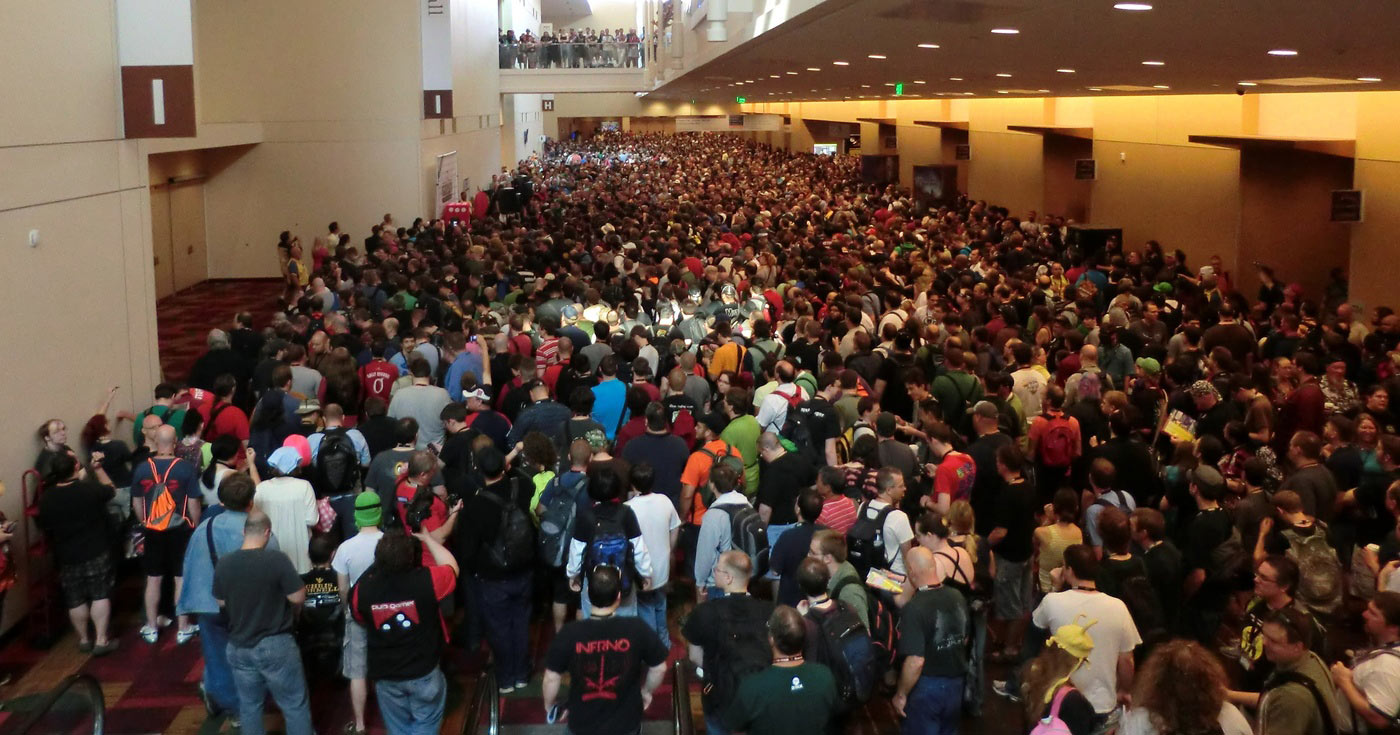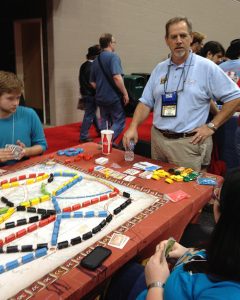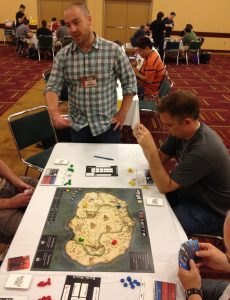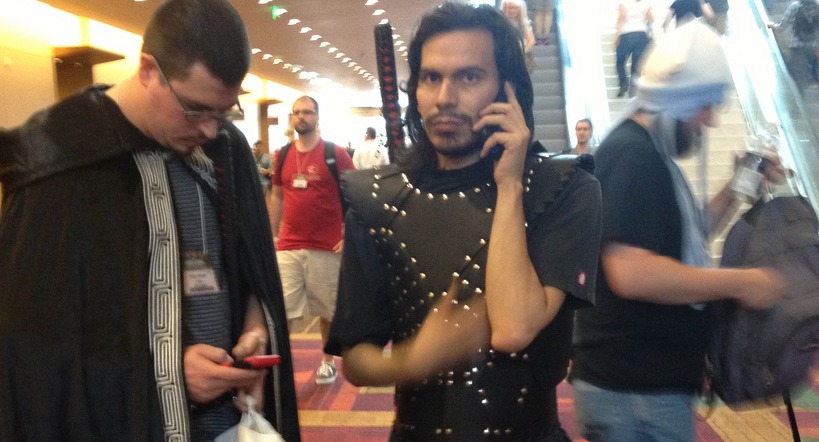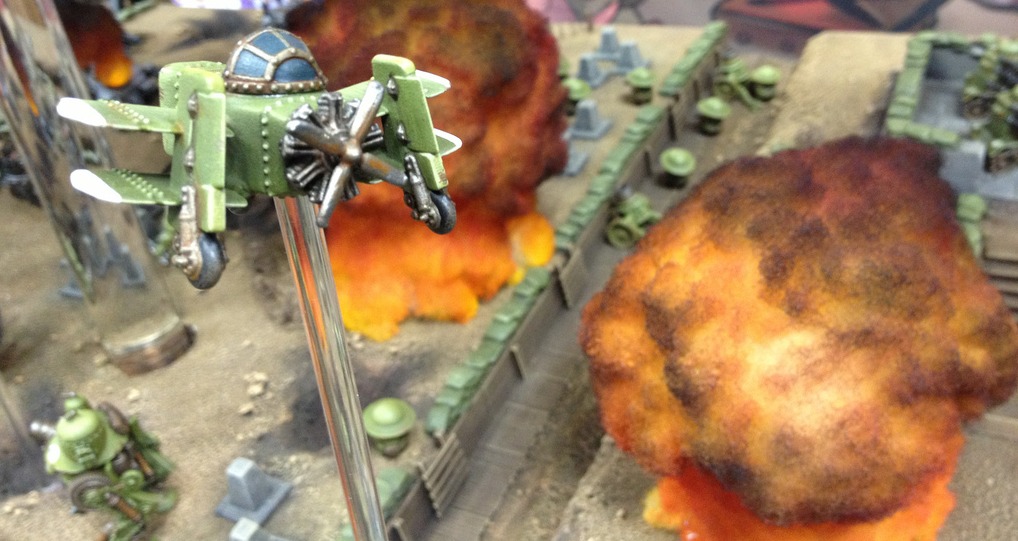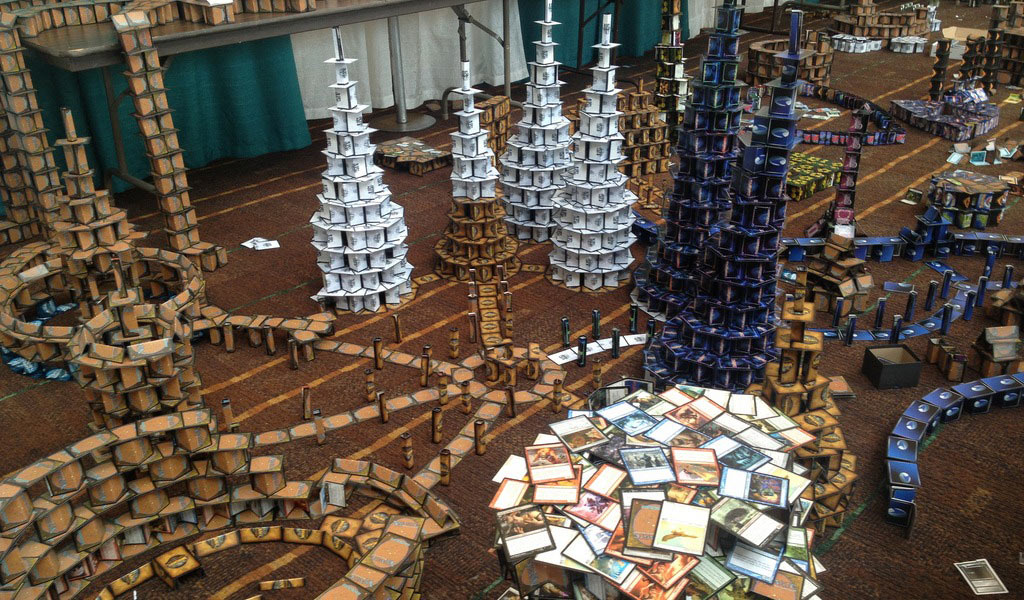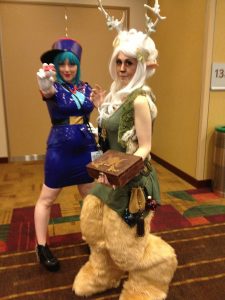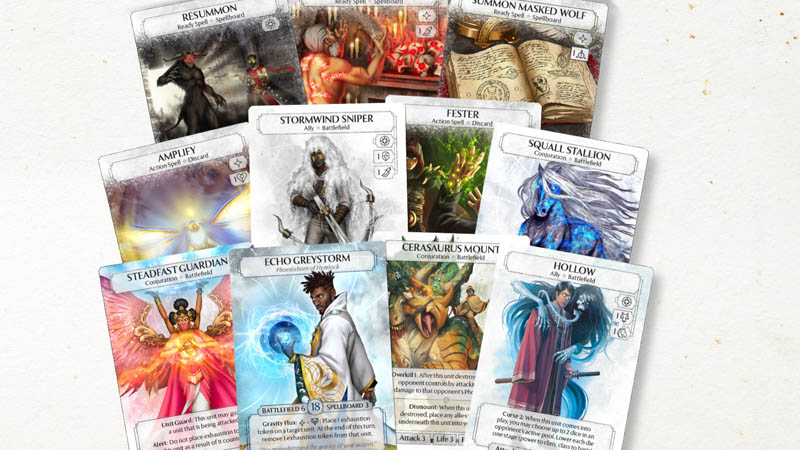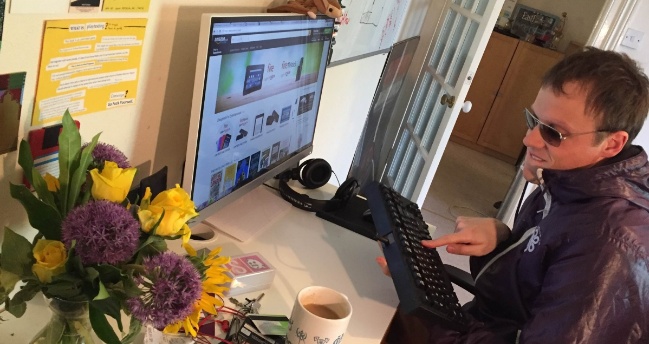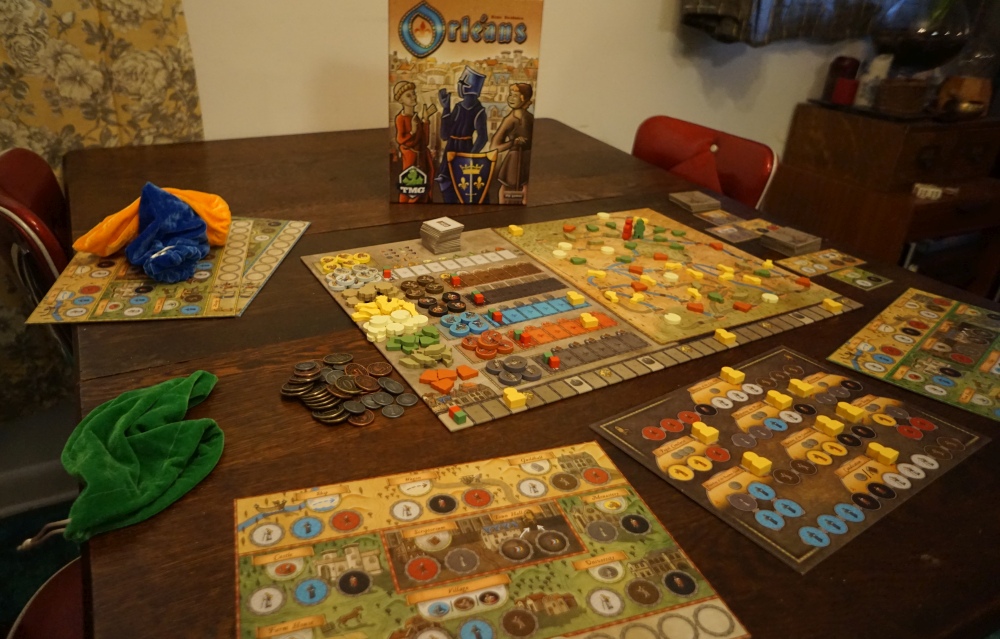Indianapolis is a city generally known for auto racing and being the birthplace of America’s first 20th-century outlaw. Every August, though, it hosts almost 50,000 people who care little for either of those things.
They come for the sweet aroma of freshly punched cardboard counters, for the textured heft of rank upon rank of miniature figures, for the piles of weird dice slimed with the cast-off condiments of terrible convention center food, and for the sight of dozens on dozens of costumed geeks, scantily clad and otherwise, who’ve traveled from all over the nation and beyond for an event that’s billed as “The Best Four Days in Gaming,” and which does in fact give tabletop gamers and steampunk airship captains alike a formidably long weekend on which to celebrate their passion and ours: tabletop games.
This is Gen Con. Its origins lost to the mists of time, the nearly half-century-old gaming party — for that’s what it is — is probably the largest annual gathering of tabletop gamers outside Germany’s Spiel. I arrived midday on Thursday, just as Day One was getting into full swing. The Indiana Convention Center is a massive place, and, as is the habit among Actual Journalists, I wandered into it unaided by map or signpost, following the flow of musky t-shirts into the first exhibit hall I could find. The simple elegance of what greeted me there felt both surprising and inevitable at once. Because what’s special about Gen Con is that it’s about the one thing most important to the cardboard arts: playing games.
And it’s brilliant to see. Imagine three football pitches (or four football fields, if you’re American), filled to the brim with people playing board games. Thousands of them. A random sampling revealed everything from giant Settlers of Catan sets to various flavors of Game of Thrones, Letters From Whitechapel, Munchkin, The Resistance, Smash Up, Ticket to Ride, and a game whose title I first took to be Hours & Hours but which on closer inspection turned out to be Axis & Allies. It was a glorious, chattering sea of fun, complete with styrofoam swords, kids rolling giant plush dice, ninjas on cell phones, and a life-size standee of Wil Wheaton that was replaced by one made of cardboard when Wil himself wasn’t in the hall.*
Across the way was the even larger exhibitor’s hall, where more than 350 publishers, retailers, artists, authors, mini-makers, and t-shirt vendors had gathered to show off products new and old — and to sell them, if at all possible. But this hall too was filled with people playing games. Publishers are there to sell, yes. But more importantly, they’re there for some face time with their fans. Because the most beautiful of the many gorgeous things about tabletop gaming (though not more beautiful than Paul) is the fact that it’s all about spending time with other people.
Like sex, it can’t be done without at least one other person in the room (more or less). And so for a board gamer to get to play a game as its publisher looks on, or to be taught a new game by the game’s designer himself, to hear about a game that’s hardly been released from the person who’s releasing the game — these things are really cool. Not as cool as italics, but still. Really cool.
Of course, I hadn’t come there for all that; I’d come to write about games. I needed to chat to publishers, to snap pictures of corsets, to suss out the particular cultural moment being forged in the halls. Time and again, though, I found myself dragged back to the table.
At first it was for work: I wandered over to the Plaid Hat Games booth intending to seek out designer-turned-entrepreneur Colby Dauch, whom I’d interviewed a few weeks before. Instead I spotted Isaac Vega, designer of the newly released BioShock Infinite: The Siege of Columbia. I’d brought BioShock to a game night two weeks prior, but when my fellow players spotted its unpunched counters and unthumbed rulebook, they decided we’d take a pass — at least until I could convincingly fake knowing how it worked. So when Vega offered to teach the game to me and another con-goer who happened to be looking on, I could hardly say no. We did our best to grok the roles of Booker and Elizabeth, both in the fiction of this prequel and in the game mechanics themselves. Dave, my opponent, declared the movement rules “fiddly,” and Vega admirably suppressed 98% of a frown. We struggled through three turns before I had to run to an appointment that did not involve playing a game, while behind us came shouts of “Noooo!!” and “Oh my god!” from the group playing Vega’s brilliant debut design, City of Remnants. The jury’s still out on BioShock Infinite, but hey, it doesn’t matter: I can bring it back to game night with the story of how its designer himself taught me the game.
A bit of it was curiosity. In the forbiddingly named First Exposure Playtest Hall, aspiring designers trotted out their wares for eager playtesters. I didn’t beat Grant “Farmageddon” Rodiek at his fine new prototype, Battle For York, but I did well enough to raise his ire — which I count a greater victory still — and I got to hear about the evolution of a his attractive and polished wargame. Run-ins with Chevee “Scallywags” Dodd, Tim “I’m like the publisher guy” Lee, and Cole “GUBS” Medeiros were just as edifying. They and the other designers I spoke to all told me the exact same thing: “It was a great playtest, everyone had great feedback, and I know exactly what changes I need to make now to turn this into a great game.” Will publishers pick them up? It’s impossible to tell from here. But at Gen Con you don’t have to wait for the answer: you can just go and play their games.
A bit of it was fun: One of the best games I played at Gen Con was an Antoine Bauza and Bruno Cathala design ostensibly pitched for 8-year-old kids: The Little Prince: Make Me A Planet. And while yes, an 8-year-old might well enjoy it, I ended up playing it only in bars and restaurants, and only with adults, most of them a couple of beers past their bedtime story. Which, it turns out, is the perfect demographic for this game, as it offers just enough cut-throat opportunity to hold your attention for the 30 minutes it takes to play, without imposing any more math than it takes to count volcanoes. (Okay, there’s some multiplication in there, but the volcanoes were harder to figure, somehow.) It’s a simple but impressive piece of design, which I got to play over lunch at a racing-themed restaurant that served hamburgers weighing in at a full pound. Somewhere in here there must be that cultural moment, I thought to myself. But no, it eluded me. I had missed it somehow. Perhaps if I’d gone for the pound of burger, instead of wimping out with the half-pounder….
It wasn’t until later the same day, as I stood at a table in the bar of the nearby J.W.Marriott hotel, frantically rolling and re-rolling dice, shouting at my partner for “More ones! More ones!” with the word “Launch!” ready to leap off my tongue as soon as what we had taken to calling an “ass torpedo” had been assembled (for such are the trials of Space Cadets: Dice Duel), that I realized: this was all there was. I hadn’t missed anything at all. I’d been prowling the halls, pen in hand, trying to learn as much about “board gaming” as I could, when there was plenty of board gaming going on right there in front of me. This convention was about just what it advertised itself as, no more and no less. All I needed to do to see it was to take up my dice and learn from the games themselves.
I wax biblical, of course (as when don’t I?), but somewhere in there is a point. All this may sound pretty fundamental to those familiar with The Hobby. But to the uninitiated, the notion of a convention at which you actually engage in the activity the convention is about is fairly unusual. One of the hazards of Actual Journalism is that one finds oneself too often at conferences, conventions, and confabs covering all manner of subject matter. But you don’t go around a banking conference making deposits (nor withdrawals, sadly), and you don’t spend your days at a literary conference reading books. For the most part, you’re talking about these things, or, even worse, listening to other people talk about them. But at Gen Con, the subject and predicate are perfectly matched: people come to Gen Con to play games.
And they take that spirit home with them, spreading the gospel as they go. It might take the form of the latest extravaganza from Fantasy Flight Games, where the line to get into their Gen Con store stretched around neighboring booths and required show-floor traffic cops to maintain order. Or it might be a set of cutely menacing World-War-One-bots for Rivet Wars (above). Approximately 49,999 of the 50,000 attendees went home with a steampunk corset, while others satisfied themselves with a simple pick-up-and-player like The Little Prince or The Three Little Pigs (almost as awesome), or even just a t-shirt. Gen Con is filled with things, and hundreds of thousands of them every year get scattered to the corners of the world with the gamers who take them home, tiny pinpoints of gamingness, all linked by the experience of having been in Indy together for four solid days of playing games.
It’s a good thing, too. Because while this kind of thing might be old hat to most SU&SD readers, the cardboard Word still has far to travel, believe me. Out in the wider universe, even the phrase “Ticket to Ride” is occasionally met with blank stares — until someone perks up and says, “Oh yeah! The Beatles song.” Like Nutella across the supple curves of a standard reference pear, the gospel needs spreading. Board gaming needs its ambassadors, and Gen Con is a great place to become one.
The ambassadors you meet there, of course, aren’t always everything you hope for. I’m a big believer in flying one’s freak flag as high as possible — but please, run it through the wash now and again. And while racial diversity isn’t the conference’s strong suit, it isn’t its weakest either. Yes, there are the churlish publishers who are wasting space in the hall (you know who you are), and the hard and frustrated core, complaining about deceptive conference retail pricing (which, yes, does exist) and how Ogre was a better game before the whole Kickstarter thing. But for the most part, everyone’s terribly friendly, and the fact that they’re all on such a board gaming high doesn’t hurt.
But then you spot the guy in the “Making love is something my girlfriend does while I fuck her” t-shirt, and you feel momentarily sorry for the whole damn thing. Really? You couldn’t stay home and pretend you actually have a girlfriend? Or better yet, stop thinking you need one and just be whoever you actually are? We’d like you a lot better, believe me.
Sigh.
It’s getting late. And once again, I’m past my deadline. Gen Con, then. It’s not like other conferences. It’s not the kind of place you go expecting to find new ideas and new inspirations, and get instead a pile of whitepapers, advertising flyers, and catalogs best used to insulate your drafty stairwell. There are ideas and inspirations to be had there, yes. But most of them float away on diaphanous wings because the hands that might have held them down are too busy rolling dice, placing tiles, trying to decide who’s trying to convince you they’re trying to sabotage the mission even though they’re actually on your team and how the hell can you convince them of that without giving the game away to the real saboteur?? and fondling miniatures, compulsively rearranging hands of cards, even rolling and moving, dammit, or just quietly buying a second copy of Tokaido in case you really do want to frame the board and hang it on your living room wall.
From Gen Con, even on a modest budget, you come home increased, more bountiful, a better evangelist for having stories to tell about the games you played and the people you played them with. From Gen Con, you come home with games to play. Games! The instruments of fun. What could be better than that?
* I’ll admit to being something of a Wil Wheaton fanboy, but I just couldn’t resist the joke. Sorry, Wil!

